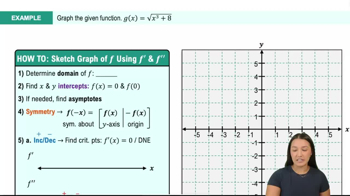Table of contents
- 0. Functions7h 52m
- Introduction to Functions16m
- Piecewise Functions10m
- Properties of Functions9m
- Common Functions1h 8m
- Transformations5m
- Combining Functions27m
- Exponent rules32m
- Exponential Functions28m
- Logarithmic Functions24m
- Properties of Logarithms34m
- Exponential & Logarithmic Equations35m
- Introduction to Trigonometric Functions38m
- Graphs of Trigonometric Functions44m
- Trigonometric Identities47m
- Inverse Trigonometric Functions48m
- 1. Limits and Continuity2h 2m
- 2. Intro to Derivatives1h 33m
- 3. Techniques of Differentiation3h 18m
- 4. Applications of Derivatives2h 38m
- 5. Graphical Applications of Derivatives6h 2m
- 6. Derivatives of Inverse, Exponential, & Logarithmic Functions2h 37m
- 7. Antiderivatives & Indefinite Integrals1h 26m
- 8. Definite Integrals3h 25m
5. Graphical Applications of Derivatives
Curve Sketching
Problem 4.4.26
Textbook Question
Graphing functions Use the guidelines of this section to make a complete graph of f.
f(x) = x³ - 147x + 286
 Verified step by step guidance
Verified step by step guidance1
Identify the function f(x) = x³ - 147x + 286 and determine its degree and leading coefficient to understand its end behavior.
Find the first derivative f'(x) to locate critical points, which will help in determining where the function increases or decreases.
Set the first derivative equal to zero and solve for x to find the critical points, which will indicate local maxima and minima.
Evaluate the second derivative f''(x) at the critical points to determine the concavity of the function and confirm whether each critical point is a local maximum or minimum.
Plot the critical points, y-intercept, and any inflection points on a coordinate plane, and sketch the graph of the function considering the end behavior and concavity.
Was this helpful?

 11:41m
11:41mWatch next
Master Summary of Curve Sketching with a bite sized video explanation from Callie
Start learning




